GL Enhances GSM A over IP Interface Emulator
Welcome to another July 2017 issue of GL's Newsletter providing information and insights into our enhanced MAPS™ GSM A over IP Interface Emulator. It has been enhanced to support Handover Management procedures, CSV based Subscriber profiles files and more.
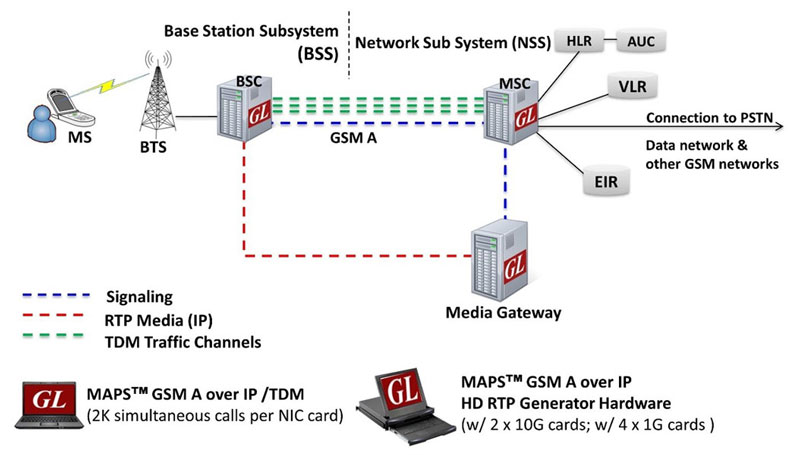
Overview
GL’s MAPS™ GSM A over IP Interface Emulator is an advanced protocol simulator/tester for GSM Simulation over A Interface that can exchange BSSMAP and DTAP messages and signaling specification as defined by 3GPP standards. The tester supports testing network elements MSC and BSC, error tracking, regression testing, conformance testing, load testing/call generation and generation of high volumes of GSM traffic.
MAPS™ GSM A over IP Emulator can run pre-defined test scenarios against DUTs in a controlled & deterministic manner. It supports mobility management procedures such as Location Management Procedure, Mobile Originating and Terminating Procedures, and Handover Management Procedures. The emulator can run pre-defined test scenarios against GSM A over IP interface test objects in a controlled & deterministic manner. With the purchase of RTP Core license (PKS102), MAPS™ GSM A over IP application supports simulation of CS domain RTP traffic such as, digits, voice file, video, tone, fax, and VQT over IP networks. The application also supports send/receive SMS simultaneously using signaling channel.
MAPS™ GSM A over IP also supports load testing (high volume of calls with traffic) using MAPS™ HD (High Density) (PKS109), a network appliance that is designed to easily achieve up to 20,000 endpoints per appliance (5000 per port). Using a stack of multiple servers, a larger test system with 100K-200K calls (all controlled from a single Master Controller.) is achievable for enterprise to carrier grade testing.
Recent Enhancements
A few significant enhancements included with the latest MAPS™ GSM A over IP Emulator are: Support for Handover Management procedures, Support for CSV based Subscriber profiles files for load testing, User-defined Statistics and Graph generation. These are discussed briefly below:
Handover Management Procedure
When a mobile user travels across two different cell coverage areas within an active call duration, the call is transferred to the new cell’s base station. When the user is travelling across two different cell coverage areas, the Handover procedures are initiated from old BSC to new BSC via MSC. These procedures can be simulated using MAPS™ GSM A over IP Emulator.
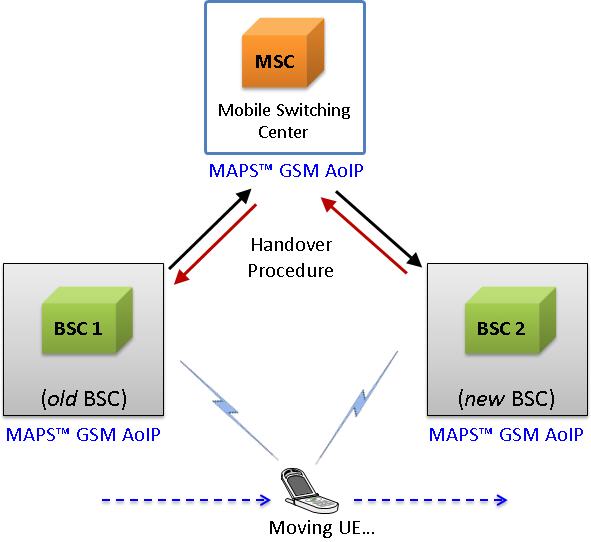
Handover Management Procedure
The following diagram depicts the typical end-to-end call flow between the entities during the Handover procedure:
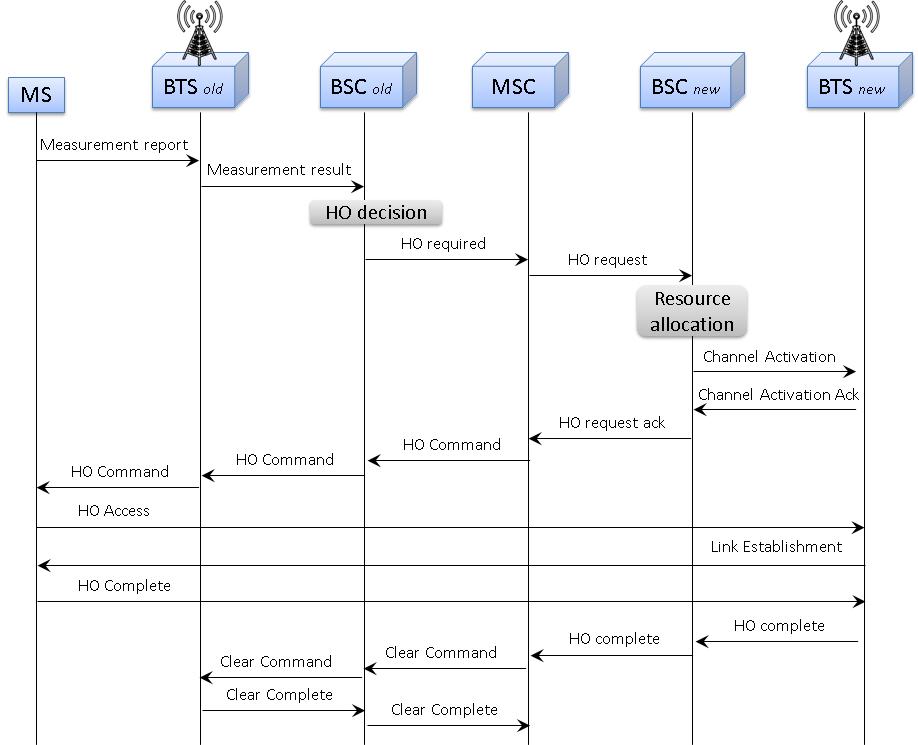
Typical Handover Management Call Procedure
The following screenshot depicts the end-to-end Handover call flow between the old BSC and new BSC via MSC simulated using MAPS™ GSM A over IP Emulator.
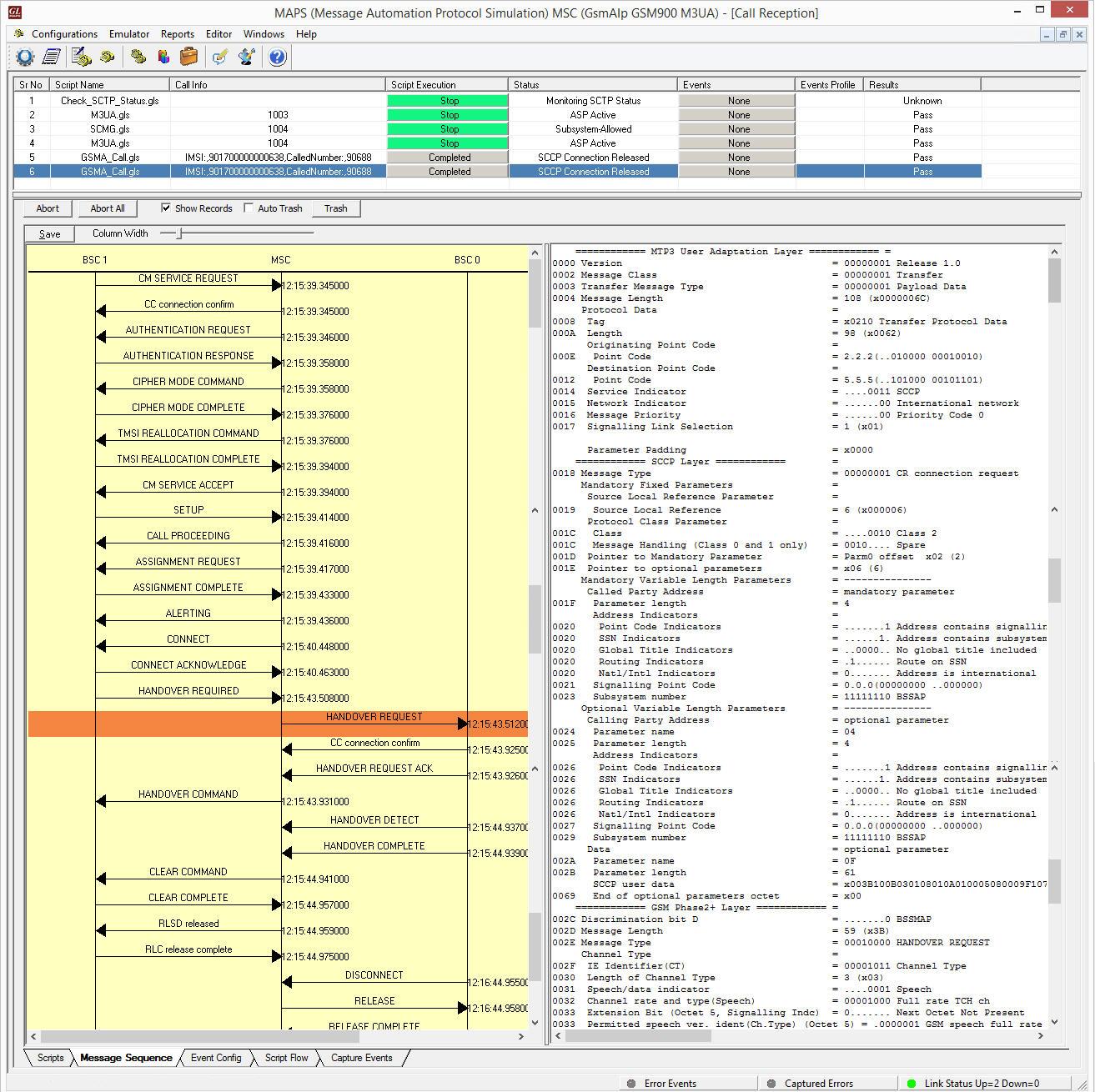
Handover Management Procedure Simulation using MAPS™
Generating Bulk Subscriber Profiles using Database, and CSV methods
To perform Bulk Call Generation, several UE/Subscriber configuration files are required. The UE/Subscriber configuration files can be created using regular Profile Editors (XML Based), using CSV based profiles, or using Auto Generation feature. MAPS™ GSM A over IP supports CSV based profiles, with which, it is possible to define up to 20,000 subscriber entries with unique called number, calling number, and other subscriber specific information. For massive UE simulation, it is recommended to use CSV option, with which MAPS™ access the UE related information directly from CSV files. The CSV files are created based on the following key parameters:
- CSV File Name for Key IMSI: Here the CSV profiles are loaded based on the key parameter such as IMSI. The CSV file is created and configured with different Parameters like IMSI, TMSI, Subscriber Number etc., which is used as database to simulate N number of Subscribers. During Call Generation, ‘GetNextRecord’ command in the script is automatically executed for each call so that the next subscriber value in the CSV file is accessed using the key identifier: IMSI.
- CSV File Name for Key Calling Number: Here the CSV profiles are loaded based on the key parameter such as Calling Number. The CSV file is created and configured with different parameters like IMSI, TMSI, and Subscriber Numbers etc. which are used as database to simulate N number of Subscribers. During Call Reception, the incoming call is handled based on the key identifier: Called Number. Once the call is received, it will search the CSV file for the Called Number. Using the ‘GetRecord’ command the unique IMSI, TMSI, etc. parameter values for the subscriber is fetched from the CSV file.
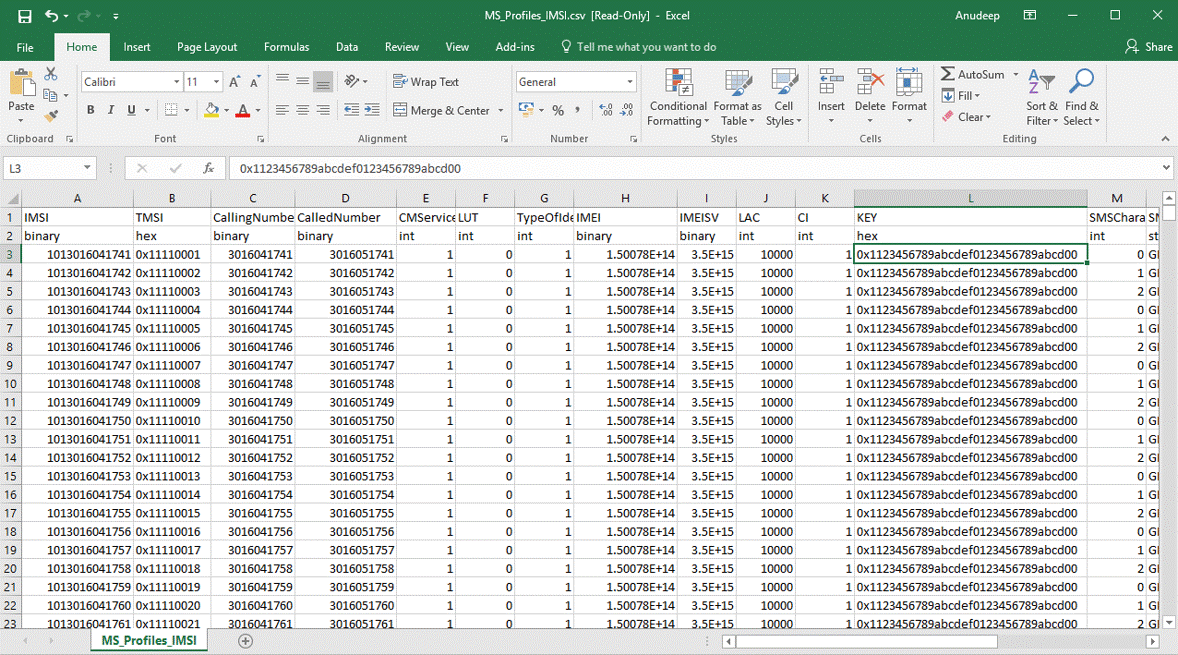
IMSI, TMSI Parameter Values
Ratio of SMS and Voice Calls for CSV
As in real-time scenario, MAPS™ GSM A over IP supports simulation of different types of calls such as Mobile Originated Voice Calls, Mobile Originated SMS, Location Updates, and more. However, it is not easy to change and maintain the CSV based subscriber profiles for different type of call simulation. So, MAPS™ includes an option to configure the Ratio (%) of SMS Calls out of Total Number of Calls, based on which MAPS™ will generate SMS with MO Voice calls.
Example: If the SMS call Ratio is configured as 30% in Testbed, then during bulk call simulation, MAPS™ generates 30% SMS calls and remaining 70% of total calls generated will be MO Voice calls.
User Defined Graphs and Statistics for Signaling and RTP Traffic
All call handling scripts are assessed by MAPS™ GSM A over IP to provide statistical information. Corresponding graphs can be generated for monitoring signaling and traffic performance. Users can customize voice quality statistics parameters for RTP, which includes metrics such as Listening MOS, Conversational MOS, Packet Loss, Discarded Packets, Out of Sequence Packets, Duplicate Packets, Delay and Jitter. These statistics are calculated and updated periodically on run time.
User can also customize scripts to create various types of graphs such as Pie graph, Line graph, Multi-Line graph, Bar graph, and Point graph to plot RTP statistical information.
Report generation ability allows further to export call statistics in PDF and XML file formats.
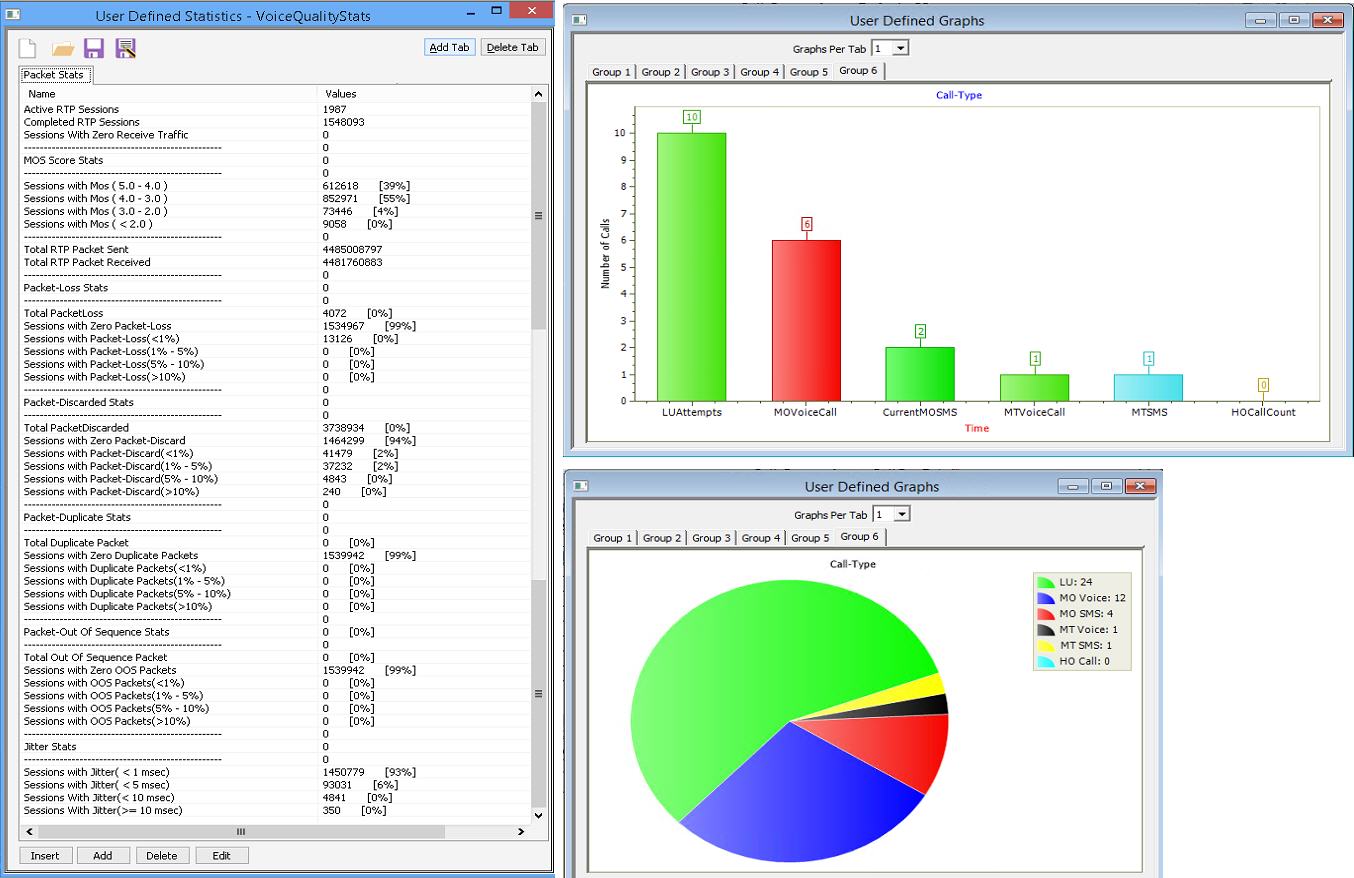
User defined Statistics and Graphs
Other Enhancements includes:
- Consolidated traffic profile (TrafficProfile.xml) for handling voice file, tones, digits, and user defined traffic allows simultaneous calls to be simulated with different traffic types
- Supports M3UA termination type as IPSP for Point to Point associations, along with signaling gateway process (SGP), and application server process (ASP)
Important Applications
- ‘MAPS™ 2G Wireless Lab Suite’ can setup a virtual real-time 2G-GSM GPRS network
- Multi-protocol, Multi-interface Simulation
- Provides fault insertion, and erroneous call flows testing capability
- Performance testing, Load testing, Functional testing, Regression testing and Conformance testing of network elements
- Ready scripts makes testing procedure simpler, less time consuming and hence time to market products
- Test response of network against protocol message modification, or corruption
- Inter-operability testing of networks
- Wrap-around testing (WAT)
- SMS Testing from within the Wireless Infrastructure using MAPS™
 Back to Newsletter Index Page
Back to Newsletter Index Page